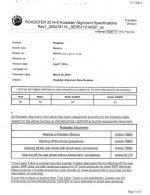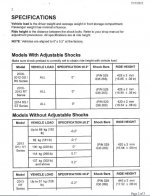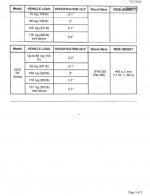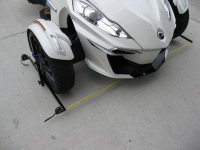stmike asked what the manual spec for toe-in is. The above is what the manual spec is. There is no toe-in spec for laser alignment. The toe-in values that are used for laser alignment have been determined by trial and error. And yes, the factory specs are based on using strut bars. I suspect the real world toe-in variation between using the bars and not is probably not much.
If we are going to be sticklers for the conditions spelled out for the factory method, shouldn't there be equivalent controls on ride height while doing laser alignments? From what I read, and my own experience, the real world impact of variable heights while doing laser alignments is inconsequential.
Not at all being a stickler. The two methods are apples to oranges, but I suppose, ultimately, you will be eating.
FWIW, included with the FoxShox I purchased were details from BRP regarding what they wanted the ride height to be.
In regards to the laser specs, no doubt, in some ways it was trial and error, however, chassis setup tends to be pretty well established in regards to front wheel alignment, what settings work well in general on many vehicles, vs those settings that do not.
Since I do not have at this time, nor do I use a laser setup, my own settings were found. Ironically, those settings are very close to accepted typical toe in amounts and provides proper turn in, stability and freedom in rolling while having virtually no tire wear.
FWIW, I had aligned our Spyder in early 2014 prior to installing the FoxShox. The tire wear on the oem Kendas was very little, and the stability was proven. After I installed the FoxShox, I was lazy and held off on realigning the Spyder. The FoxShox increased the front ride height slightly, not exactly certain but believe it was 3/4". The result of the increased ride height to the chassis, same riders, at the same weight, was noticeable wear to the front tires in a couple hundred miles. However, raising the Spyder with the FoxShox, increased toe in, so the straight line and cornering handling was very stable. Noticing the tire wear, I needed a new baseline for the FoxShox added spring stiffness. As I did before, I asked a friend to help, his task was simply to sit on the Spyder as he had done on the previous alignment. With that, I made the adjustment to what I considered proper toe in. Doing so again freed up the chassis allowing it to simply keep on rolling with little effort, tire wear was no longer a concern, and handling was improved with better turn in and similar straight line stability.
I have checked and adjusted other Spyders also. From factory new, a 2018 had complaints from the owner. After resetting to the specs I prefer, the Spyder settled down and became stable both going straight and cornering.
One Spyder I was asked to check had recently gotten new tires on the front. The owner was concerned about the rapid wear. With him seated on the Spyder, and his machine has stock front shocks, the toe in amount was far beyond the numbers I utilize. This Spyder had been previously aligned by the laser method and was out of alignment a lot. After resetting the toe in, the tire wear diminished, and he immediately noticed how easily it rolled.
If you have read this far, then you will see, at least when I help people setting up their toe in, the stickler for control of ride height is not a rigid bar or dimension, but rather the Spyder is aligned with the rider seated on the machine. Essentially, that is where the ride height settles to.




